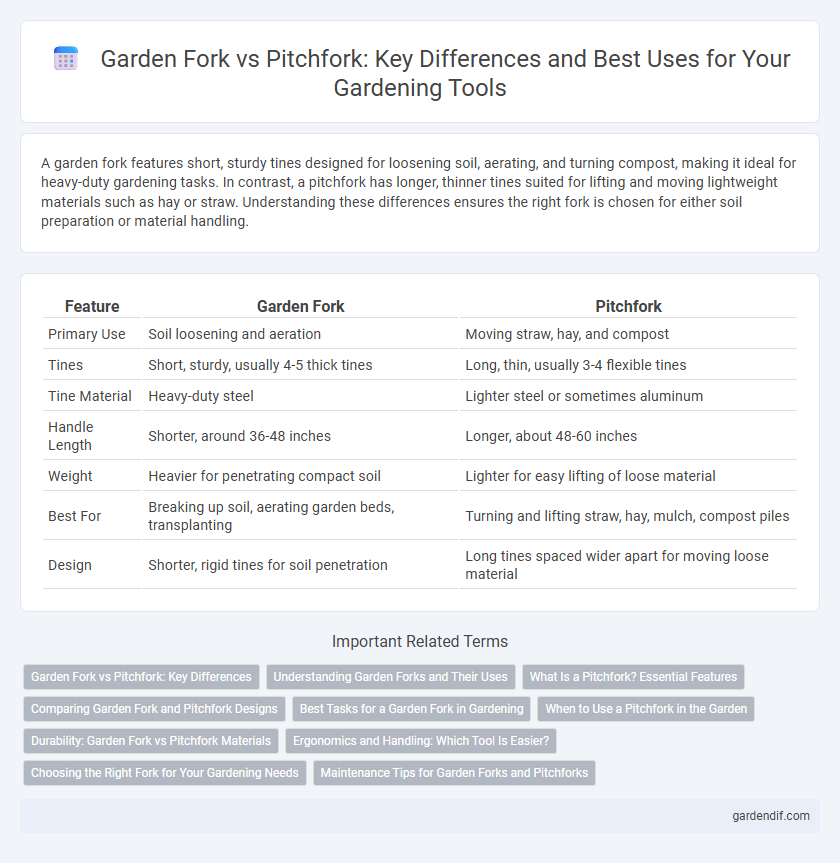
Garden fork vs pitchfork Illustration
A garden fork features short, sturdy tines designed for loosening soil, aerating, and turning compost, making it ideal for heavy-duty gardening tasks. In contrast, a pitchfork has longer, thinner tines suited for lifting and moving lightweight materials such as hay or straw. Understanding these differences ensures the right fork is chosen for either soil preparation or material handling.
Table of Comparison
| Feature | Garden Fork | Pitchfork |
|---|---|---|
| Primary Use | Soil loosening and aeration | Moving straw, hay, and compost |
| Tines | Short, sturdy, usually 4-5 thick tines | Long, thin, usually 3-4 flexible tines |
| Tine Material | Heavy-duty steel | Lighter steel or sometimes aluminum |
| Handle Length | Shorter, around 36-48 inches | Longer, about 48-60 inches |
| Weight | Heavier for penetrating compact soil | Lighter for easy lifting of loose material |
| Best For | Breaking up soil, aerating garden beds, transplanting | Turning and lifting straw, hay, mulch, compost piles |
| Design | Shorter, rigid tines for soil penetration | Long tines spaced wider apart for moving loose material |
Garden Fork vs Pitchfork: Key Differences
Garden forks feature short, strong tines designed for digging and turning soil, making them ideal for aerating garden beds and breaking up compacted ground. Pitchforks typically have longer, thinner tines suited for lifting and moving loose materials like hay, compost, or straw. The main difference lies in tine shape and function, with garden forks providing more leverage for soil penetration, while pitchforks excel at handling lightweight, bulky materials.
Understanding Garden Forks and Their Uses
Garden forks feature short, sturdy tines ideal for loosening soil, removing weeds, and aerating garden beds. Unlike pitchforks, which have longer, thinner tines designed for moving hay or compost, garden forks provide better control and leverage in dense or compacted earth. Their robust construction makes them essential for tasks requiring soil penetration and turning without damaging root systems.
What Is a Pitchfork? Essential Features
A pitchfork is a long-handled gardening tool with typically three to five sturdy, pointed tines designed for lifting and tossing loose materials like hay, compost, or manure. Its tines are straighter and sharper than those of a garden fork, enabling efficient penetration into lightweight materials without excessive soil disruption. The pitchfork's lightweight design and spaced tines make it ideal for aerating compost piles and moving bulky organic matter in gardening and farming tasks.
Comparing Garden Fork and Pitchfork Designs
Garden forks feature thick, short tines designed for digging and turning soil, offering durability and strength ideal for heavy garden tasks. Pitchforks have longer, thinner tines optimized for moving loose materials like hay or compost, providing lighter weight and better penetration in softer substances. The contrasting tine length, thickness, and spacing define their specialized use and ergonomic efficiency in gardening and farming.
Best Tasks for a Garden Fork in Gardening
A garden fork excels at loosening compacted soil, aerating garden beds, and turning compost due to its sturdy, closely spaced tines. It is ideal for breaking up hard ground without damaging plant roots, making it perfect for preparing seed beds or transplanting perennials. Unlike a pitchfork, which is designed for moving loose materials like hay, the garden fork's robust construction supports heavy-duty soil cultivation tasks.
When to Use a Pitchfork in the Garden
A pitchfork is essential for moving lightweight, bulky materials such as hay, straw, or compost in the garden, where its long, widely spaced tines efficiently lift and turn organic matter without compacting the soil. Use a pitchfork when aerating compost piles or spreading mulch to promote better decomposition and moisture retention. Unlike a garden fork, it is not suited for digging or breaking hard soil but excels in handling loose, fibrous materials.
Durability: Garden Fork vs Pitchfork Materials
Garden forks typically feature tines made from forged steel, providing superior durability and resistance to bending when digging in tough soil. Pitchforks often use lighter materials such as tempered steel or aluminum, which offer less durability but increased ease of use for handling lighter materials like hay. Choosing between the two depends on the intended task, as garden forks excel in heavy-duty soil work, while pitchforks are suited for lighter, less strenuous applications.
Ergonomics and Handling: Which Tool Is Easier?
Garden forks typically feature shorter, thicker tines and a sturdy handle designed for digging and turning soil, offering better leverage and reduced strain on the wrist. Pitchforks have longer, thinner tines ideal for lifting and moving loose material like hay but may require more precise wrist control, making them slightly harder to maneuver for extended use. Ergonomically, garden forks often provide a more comfortable grip and balanced weight distribution, enhancing ease of handling during heavy soil work.
Choosing the Right Fork for Your Gardening Needs
A garden fork features shorter, sturdier tines designed for loosening and aerating soil, making it ideal for tasks like breaking up compacted earth and turning compost. A pitchfork has longer, thinner tines suited for lifting and moving lightweight materials such as hay, straw, or garden debris. Selecting the right fork depends on your specific gardening needs: choose a garden fork for soil work and a pitchfork for handling bulky, loose materials.
Maintenance Tips for Garden Forks and Pitchforks
Garden forks require regular cleaning to prevent rust and maintain tines' sharpness, which enhances soil penetration and aeration efficiency. Pitchforks benefit from occasional tine straightening and handle inspection to ensure durability and safety during heavy-duty tasks like moving compost or hay. Proper storage in a dry, sheltered area prolongs the lifespan of both garden forks and pitchforks by minimizing exposure to moisture and corrosion.
Garden fork vs pitchfork Infographic

 gardendif.com
gardendif.com